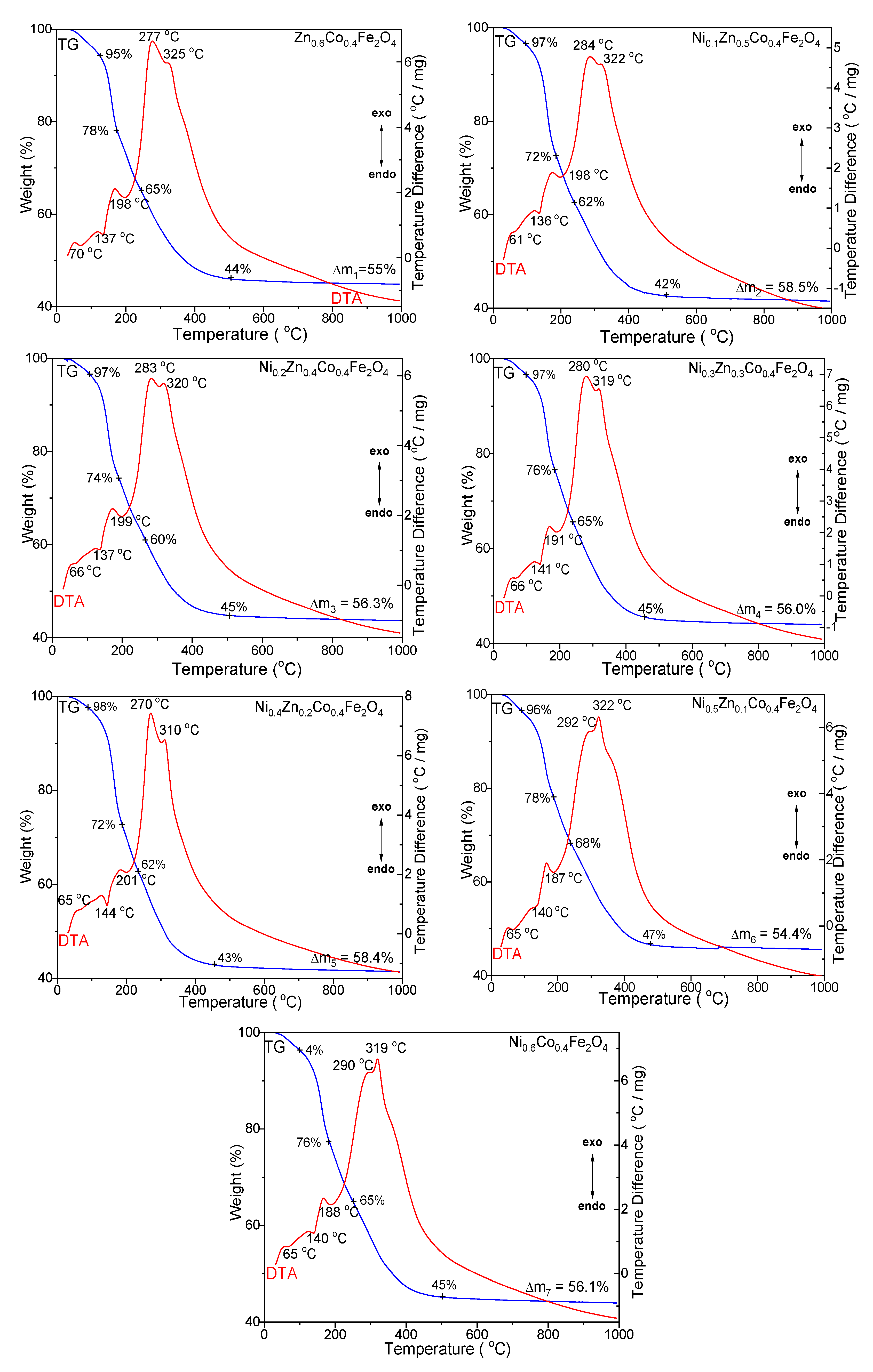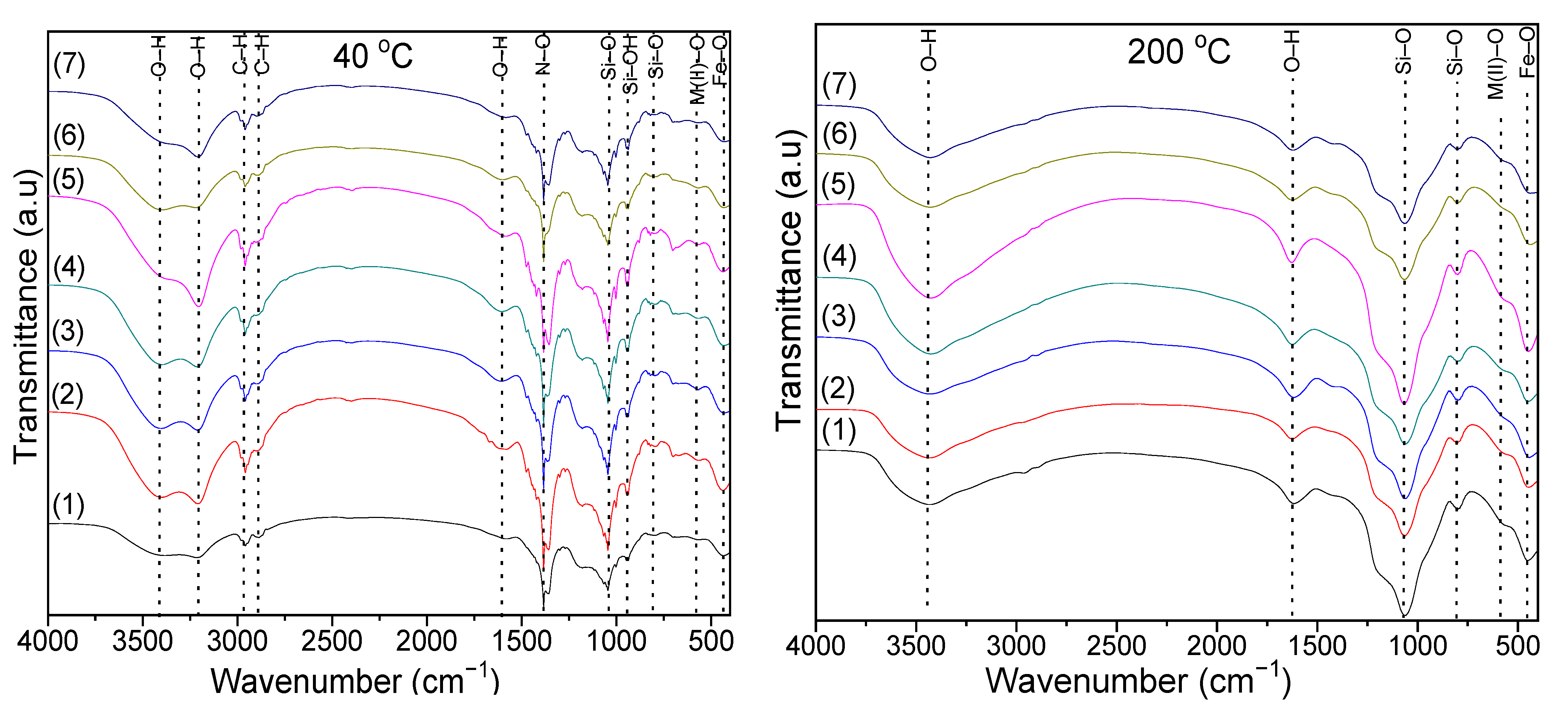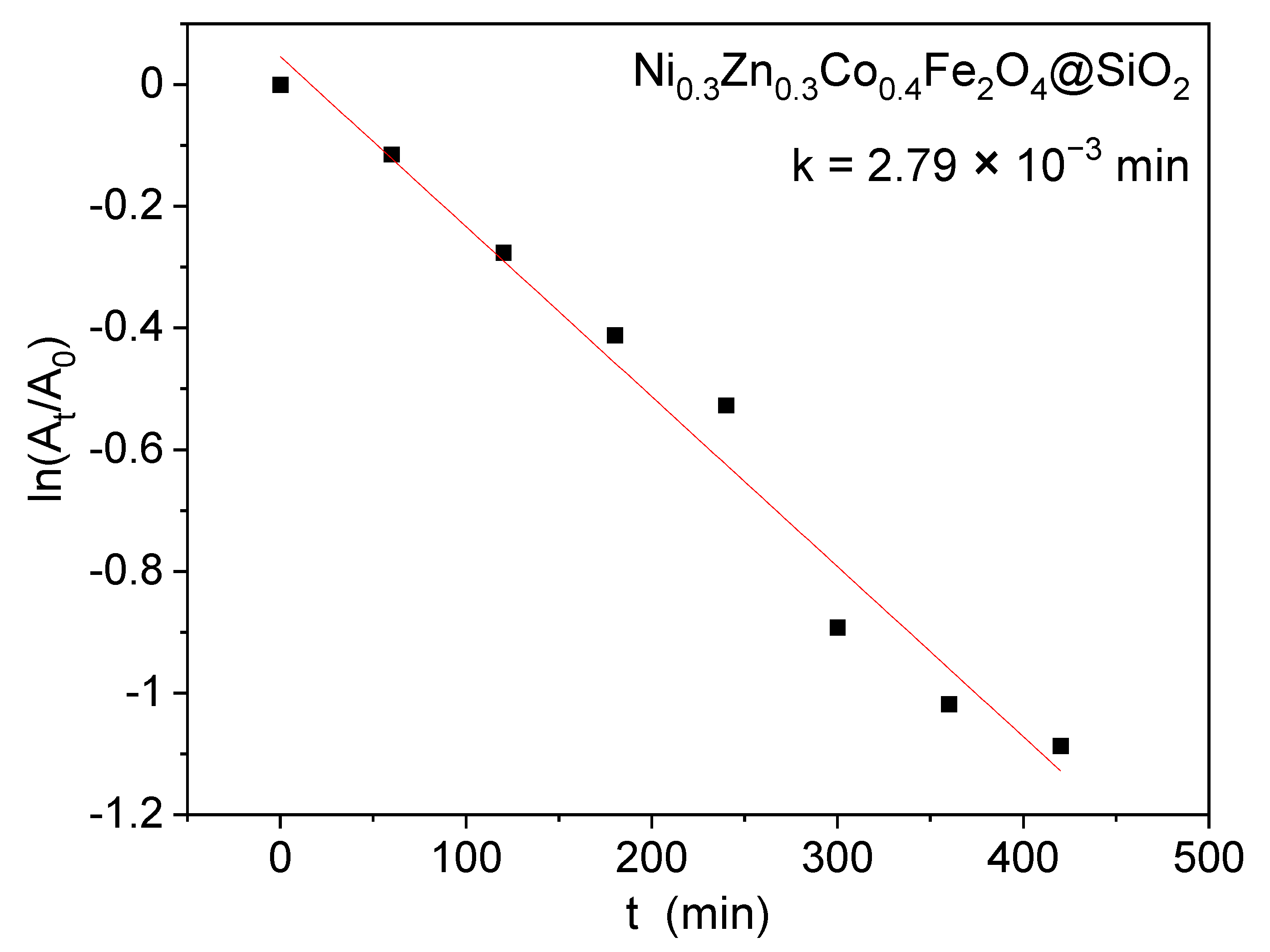Impact of Ni Content on the Structure and Sonophotocatalytic Activity of Ni-Zn-Co Ferrite Nanoparticles
Abstract
:1. Introduction
2. Results and Discussion
2.1. Thermal Analysis
2.2. FT-IR Analysis
2.3. XRD Analysis
2.4. Elemental Analysis
2.5. BET Analysis
2.6. TEM Analysis
2.7. UV-VIS Analysis
2.8. Sonophotocatalytic Activity
3. Materials and Methods
3.1. Synthesis
3.2. Characterization
3.3. Sonophotocatalysis
4. Conclusions
Author Contributions
Funding
Institutional Review Board Statement
Informed Consent Statement
Data Availability Statement
Acknowledgments
Conflicts of Interest
References
- Kefeni, K.K.; Mamba, B.B. Photocatalytic application of spinel ferrite nanoparticles and nanocomposites in wastewater treatment: Review. Sustain. Mater. Technol. 2020, 23, e00140. [Google Scholar] [CrossRef]
- Sun, M.; Han, X.; Chen, S. Synthesis and photocatalytic activity of nano-cobalt ferrite catalyst for the photo-degradation various dyes under simulated sunlight irradiation. Mater. Sci. Semicond. Process. 2019, 91, 367–376. [Google Scholar] [CrossRef]
- Rajabi, H.R.; Arjmand, H.; Kazemdehdashti, H.; Farsi, M. A comparison investigation on photocatalytic activity performance and adsorption efficiency for the removal of cationic dye: Quantum dots vs. magnetic nanoparticles. J. Environ. Chem. Eng. 2016, 4, 2830–2840. [Google Scholar] [CrossRef]
- AlSalka, Y.; Granone, L.I.; Ramadan, W.; Hakki, A.; Dillert, R.; Bahnemann, D.W. Iron-based photocatalytic and photoelectrocatalytic nano-structures: Facts, perspectives, and expectations. Appl. Catal. B Environ. 2019, 244, 1065–1095. [Google Scholar] [CrossRef]
- Abdurahman, M.H.; Abdullah, A.Z.; Shoparwe, N.F. A comprehensive review on sonocatalytic, photocatalytic, and sonophotocatalytic processes for the degradation of antibiotics in water: Synergistic mechanism and degradation pathway. Chem. Eng. J. 2021, 413, 127412. [Google Scholar] [CrossRef]
- Paustian, D.; Franke, M.; Stelter, M.; Braeutigam, P. Sonophotocatalysis—Limits and possibilities for synergistic effects. Catalysts 2022, 12, 754. [Google Scholar] [CrossRef]
- Joseph, C.G.; Puma, G.L.; Bono, A.; Krishnaiah, D. Sonophotocatalysis in advanced oxidation process: A short review. Ultrason. Sonochem. 2009, 16, 583–589. [Google Scholar] [CrossRef]
- Anjum, M.; Miandad, R.; Waqas, M.; Gehany, F.; Barakat, M.A. Remediation of wastewater using various nanomaterials. Arab. J. Chem. 2019, 12, 4897–4919. [Google Scholar] [CrossRef] [Green Version]
- Munoz, M.; De Pedro, Z.M.; Casas, J.A.; Rodriguez, J.J. Preparation of magnetite-based catalysts and their application in heterogeneous Fenton oxidation—A review. Appl. Catal. B Environ. 2015, 176–177, 249–265. [Google Scholar] [CrossRef] [Green Version]
- Matsumoto, Y. Energy positions of oxide semiconductors and photocatalysis with iron complex oxides. J. Solid State Chem. 1996, 126, 227–234. [Google Scholar] [CrossRef]
- Dillert, R.; Taffa, D.H.; Wark, M.; Bredow, T.; Bahnemann, D.W. Research Update: Photoelectrochemical water splitting and photocatalytic hydrogen production using ferrites (MFe2O4) under visible light irradiation. APL Mater. 2015, 3, 104001. [Google Scholar] [CrossRef] [Green Version]
- Taffa, D.H.; Dillert, R.; Ulpe, A.C.; Bauerfeind, K.C.L.; Bredow, T.; Bahnemann, D.W.; Wark, D. Photoelectrochemical and theoretical investigations of spinel type ferrites (MxFe3−xO4) for water splitting: A mini-review. J. Photon Energy 2017, 7, 012009. [Google Scholar] [CrossRef] [Green Version]
- Chakrabarty, S.; Bandyopadhyay, S.; Pal, M.; Dutta, A. Sol-gel derived cobalt containing Ni–Zn ferrite nanoparticles: Dielectric relaxation and enhanced magnetic property study. Mater. Chem. Phys. 2021, 259, 124193. [Google Scholar] [CrossRef]
- Sepelak, V.; Feldhoff, A.; Heitjans, P.; Krumeich, F.; Menzel, D.; Litterst, F.J.; Bergmann, I.; Becker, K.D. nonequilibrium cation distribution, canted spin arrangement, and enhanced magnetization in nanosized MgFe2O4 prepared by a one-step mechanochemical route. Chem. Mater. 2006, 18, 3057–3067. [Google Scholar] [CrossRef]
- Dolcet, P.; Kirchberg, K.; Antonello, A.; Suchomski, C.; Marschall, R.; Diodati, S.; Muñoz-Espí, R.; Landfester, K.; Gross, S. Exploring wet chemistry approaches to ZnFe2O4 spinel ferrite nanoparticles with different inversion degrees: A comparative study. Inorg. Chem. Front. 2019, 6, 1527. [Google Scholar] [CrossRef]
- Simon, C.; Zakaria, M.B.; Kurz, H.; Tetzlaff, D.; Blösser, A.; Weiss, M.; Timm, J.; Weber, B.; Apfel, U.P.; Marschall, R. Magnetic NiFe2O4 nanoparticles prepared via non-aqueous microwave-assisted synthesis for application in electrocatalytic water oxidation. Chem. Eur. J. 2021, 27, 16990–17001. [Google Scholar] [CrossRef] [PubMed]
- Kirchberg, K.; Becker, A.; Bloesser, A.; Weller, T.; Timm, J.; Suchomski, C.; Marschall, R. Stabilization of monodisperse, phase-pure mgfe2o4 nanoparticles in aqueous and nonaqueous media and their photocatalytic behavior. J. Phys. Chem. C 2017, 121, 27126–27138. [Google Scholar] [CrossRef]
- He, H.Y. Photocatalytic degradations of dyes on magnetically separable Ni1 −xCoxFe2O4 nanoparticles synthesized by a hydrothermal process. Part Sci. Technol. 2016, 34, 143–151. [Google Scholar] [CrossRef]
- Kefeni, K.K.; Mamba, B.B.; Msagati, T.A.M. Application of spinel ferrite nanoparticles in water and wastewater treatment: A review. Sep. Purif. Technol. 2017, 188, 399–422. [Google Scholar] [CrossRef]
- Casbeer, E.; Sharma, V.K.; Li, X.Z. Synthesis and photocatalytic activity of ferrites under visible light: A review. Sep. Purif. Technol. 2012, 87, 1–14. [Google Scholar] [CrossRef]
- Sundararajan, M.; Sailaja, V.; Kennedy, L.J.; Vijaya, J.J. Photocatalytic degradation of rhodamine B under visible light using nanostructured zinc doped cobalt ferrite: Kinetics and mechanism. Ceram. Int. 2017, 43, 540–548. [Google Scholar] [CrossRef]
- Stergiou., C. Magnetic, dielectric and microwave adsorption properties of rare earth doped Ni-Co and Ni-Co-Zn spinel ferrite. J. Magn. Magn. Mater. 2017, 426, 629–635. [Google Scholar] [CrossRef]
- Shetty, K.; Renuka, L.; Nagaswarupa, H.P.; Nagabhushana, H.; Anantharaju, K.S.; Rangappa, D.; Prashantha, S.C.; Ashwini, K. A comparative study on CuFe2O4, ZnFe2O4 and NiFe2O4: Morphology, impedance and photocatalytic studies. Mater. Today Proc. 2017, 4, 11806–11815. [Google Scholar] [CrossRef]
- Zhu, H.; Jiang, R.; Fu, Y.; Li, R.; Yao, J. Novel multifunctional NiFe2O4/ZnO hybrids for dye removal by adsorption, photocatalysis and magnetic separation. Appl. Surf. Sci. 2016, 369, 1–10. [Google Scholar] [CrossRef]
- Li, Y.; Zhang, Z.; Pei, L.; Li, X.; Fan, T.; Ji, J.; Shen, J.; Ye, M. Multifunctional photocatalytic performances of recyclable Pd-NiFe2O4/reduced graphene oxide nanocomposites via different co-catalyst strategy. Appl. Catal. B Environ. 2016, 190, 1–11. [Google Scholar] [CrossRef]
- Mahmoodi, N.M. Zinc ferrite nanoparticle as a magnetic catalyst: Synthesis and dye degradation. Mater. Res. Bull. 2013, 48, 4255–4260. [Google Scholar] [CrossRef]
- Revathi, J.; Abel, M.J.; Archana, V.; Sumithra, T.; Thiruneelakandan, R. Synthesis and characterization of CoFe2O4 and Ni-doped CoFe2O4 nanoparticles by chemical co-precipitation technique for photo-degradation of organic dyestuffs under direct sunlight. Phys. B Condens. Matter. 2020, 587, 412136. [Google Scholar] [CrossRef]
- Harraz, F.A.; Mohamed, R.M.; Rashad, M.M.; Wang, Y.C.; Sigmund, W. Magnetic nanocomposite based on titania-silica/cobalt ferrite for photocatalytic degradation of methylene blue dye. Ceram. Int. 2014, 40, 375–384. [Google Scholar] [CrossRef]
- Ahmadi Golsefidi, M.; Yazarlou, F.; Naeimi Nezamabad, M.; Naeimi Nezamabad, B.; Karimi, M. Effects of capping agent and surfactant on the morphology and size of CoFe2O4 nanostructures and photocatalyst properties. J. Nanostruct. 2016, 6, 121–126. [Google Scholar]
- Abbasi, A.; Khojasteh, H.; Hamadanian, M.; Salavati-Niasari, M. Synthesis of CoFe2O4 nanoparticles and investigation of the temperature, surfactant, capping agent and time effects on the size and magnetic properties. J. Mater. Sci. Mater. Electron. 2016, 27, 4972–4980. [Google Scholar] [CrossRef]
- Lassoued, A.; Li, J.F. Magnetic and photocatalytic properties of Ni–Co ferrites. Solid State Sci. 2020, 104, 106199. [Google Scholar] [CrossRef]
- Chahar, D.; Taneja, S.; Bisht, S.; Kesarwani, S.; Thakur, P.; Thakur, A.; Sharma, P.B. Photocatalytic activity of cobalt substituted zinc ferrite for the degradation of methylene blue dye under visible light irradiation. J. Alloys Compd. 2021, 851, 156878. [Google Scholar] [CrossRef]
- Bhukal, S.; Bansal, S.; Singhal, S. Structural, electrical and magnetic properties of Ni doped Co-Zn nanoferrites and their application in photo-catalytic degradation of methyl orange dye. Solid State Phenom. 2015, 232, 197–211. [Google Scholar] [CrossRef]
- Vatsalya, V.L.S.; Sundari, G.S.; Sridhar, C.S.L.N.; Lakshmi, C.S. Evidence of superparamagnetism in nano phased copper doped nickel zinc ferrites synthesized by hydrothermal method. Optik 2021, 247, 167874. [Google Scholar] [CrossRef]
- Raju, K.; Venkataiah, G.; Yoon, D.H. Effect of Zn substitution on the structural and magnetic properties of Ni–Co ferrites. Ceram. Int. 2014, 40, 9337–9344. [Google Scholar] [CrossRef]
- Huili, H.; Grindi, B.; Viau, G.; Tahar, L.B. Influence of the stoichiometry and grain morphology on the magnetic properties of Co substituted Ni–Zn nanoferrites. Ceram. Int. 2016, 42, 17594–17604. [Google Scholar] [CrossRef]
- Sherstyuk, D.P.; Starikov, A.Y.; Zhivulin, V.E.; Zherebstov, D.A.; Gudkova, S.A.; Perov, N.S.; Alekhina, Y.A.; Astapovich, K.A.; Vinnik, D.A.; Trukhanov, A.V. Effect of Co content on magnetic features and SPIN states in Ni–Zn spinel ferrites. Ceram. Int. 2021, 47, 12163–12169. [Google Scholar] [CrossRef]
- Kumar, R.; Barman, P.B.; Singh, R.R. An innovative direct non-aqueous method for the development of Co doped Ni-Zn ferrite nanoparticles. Mater. Today Commun. 2021, 27, 102238. [Google Scholar] [CrossRef]
- Kaur, M.; Jain, P.; Singh, M. Studies on structural and magnetic properties of ternary cobalt magnesium zinc (CMZ) Co0.6-xMgxZn0.4Fe2O4 (x = 0.0, 0.2, 0.4, 0.6) ferrite nanoparticles. Mater. Chem. Phys. 2015, 162, 332–339. [Google Scholar] [CrossRef]
- Vinnik, D.A.; Sherstyuk, D.P.; Zhivulin, V.E.; Zhivulin, D.E.; Starikov, A.Y.; Gudkova, S.A.; Zherebtsov, D.A.; Pankratov, D.A.; Alekhina, Y.A.; Perov, N.S.; et al. Impact of the Zn–Co content on structural and magnetic characteristics of the Ni spinel ferrites. Ceram. Int. 2022, 48, 18124–18133. [Google Scholar] [CrossRef]
- Mohapatra, P.P.; Singh, H.K.; Kiran, M.S.R.N.; Dobbidi, P. Co substituted Ni–Zn ferrites with tunable dielectric and magnetic response for high-frequency applications. Ceram. Int. 2022, 48, 29217–29228. [Google Scholar] [CrossRef]
- Ramesh, S.; Sekhar, B.C.; Rao, P.S.V.S.; Rao, B.P. Microstructural and magnetic behavior of mixed Ni–Zn–Co and Ni–Zn–Mn ferrites. Ceram. Int. 2014, 40, 8729–8735. [Google Scholar] [CrossRef]
- Stefanescu, M.; Stoia, M.; Dippong, T.; Stefanescu, O.; Barvinschi, P. Preparation of CoxFe3-xO4 Oxydic System Starting from Metal Nitrates and Propanediol. Acta Chim. Slov. 2009, 56, 379–385. [Google Scholar]
- Dippong, T.; Levei, E.A.; Lengauer, C.L.; Daniel, A.; Toloman, D.; Cadar, O. Investigation of thermal, structural, morphological and photocatalytic properties of CuxCo1-xFe2O4 (0≤x≤1) nanoparticles embedded in SiO2 matrix. Mater. Caract. 2020, 163, 110268. [Google Scholar] [CrossRef]
- Dippong, T.; Levei, E.A.; Cadar, O.; Goga, F.; Barbu-Tudoran, L.; Borodi, G. Size and shape-controlled synthesis and characterization of CoFe2O4 nanoparticles embedded in a PVA- SiO2 hybrid matrix. J. Anal. Appl. Pyrol 2017, 128, 121–130. [Google Scholar] [CrossRef]
- Amer, M.A.; Tawfik, A.; Mostafa, A.G.; El-Shora, A.F.; Zaki, S.M. Spectral studies of Co substituted Ni–Zn ferrites. J. Magn. Magn. Mater. 2011, 323, 1445–1452. [Google Scholar] [CrossRef]
- Mallapur, M.M.; Chougule, B.K. Synthesis, characterization and magnetic properties of nanocrystalline Ni–Zn–Co ferrites. Mater. Lett. 2010, 64, 231–234. [Google Scholar] [CrossRef]
- ASTM. Joint Committee on Powder Diffraction Standards-International Center for Diffraction Data; ASTM: Philadelphia, PA, USA, 1999. [Google Scholar]
- Ghodake, J.S.; Shinde, T.J.; Patil, R.P.; Patil, S.B.; Patil, S.B.; Suryavanschi, S.S. Initial permeability of Zn–Ni–Co ferrite. J. Magn. Magn. Mater. 2015, 378, 436–439. [Google Scholar] [CrossRef]
- Dippong, T.; Levei, E.A.; Cadar, O. Formation, structure and magnetic properties of MFe2O4@SiO2 (M = Co, Mn, Zn, Ni, Cu) nanocomposites. Materials 2021, 14, 1139. [Google Scholar] [CrossRef]
- Dalal, M.; Mallick, A.; Mahapatra, A.S.; Mitra, A.; Das, A.; Das, D.; Chakrabarti, P.K. Effect of cation distribution on the magnetic and hyperfine behavior of nanocrystalline Co doped Ni–Zn ferrite (Ni0.4Zn0.4Co0.2Fe2O4). Mater. Res. 2016, 76, 389–401. [Google Scholar]
- Chen, C.; Jaihindh, D.; Hu, S.; Fu, Y. Magnetic recyclable photocatalysts of Ni-Cu-Zn ferrite@SiO2@TiO2@Ag and their photocatalytic activities. J. Photochem. Photobiol. A Chem. 2017, 334, 74–85. [Google Scholar] [CrossRef]
- Meena, S.; Anantharaju, K.S.; Malini, S.; Dey, A.; Renuka, L.; Prashantha, S.C.; Vidya, Y.S. Impact of temperature-induced oxygen vacancies in polyhedron MnFe2O4 nanoparticles: As excellent electrochemical sensor, supercapacitor and active photocatalyst. Ceram. Int. 2021, 47, 14723–14740. [Google Scholar] [CrossRef]
- Sharma, D.; Khare, N. Tuning of optical bandgap and magnetization of CoFe2O4 thin films. Appl. Phys. Lett. 2014, 105, 032404. [Google Scholar] [CrossRef]
- Toloman, D.; Stefan, M.; Pana, O.; Rostas, A.M.; Silipas, T.D.; Pogacean, F.; Leostean, C.; Barbu-Tudoran, L.; Popa, A. Transition metal ions as a tool for controlling the photocatalytic activity of MWCNT-TiO2 nanocomposites. J. Alloys Compd. 2022, 921, 166095. [Google Scholar] [CrossRef]







| Nanocomposite | DTEM (nm) | DXRD (nm) | DC (%) | a (Å) | V (Å3) | LA (Å) | LB (Å) | Quantitative Analysis (%) | Ni/Zn/Co |
|---|---|---|---|---|---|---|---|---|---|
| Zn0.6Co0.4Fe2O4@SiO2 | 34 | 33.2 | 89.0 | 8.456 | 605 | 14.6 | 12.0 | 12% Zn0.6Co0.4Fe2O4/ 4% α-Fe2O3/ 84% SiO2 | 0/0.60/0.39 |
| Ni0.1Zn0.5Co0.4Fe2O4@SiO2 | 35 | 33.6 | 89.4 | 8.405 | 594 | 14.5 | 11.9 | 14% Ni0.1Zn0.5Co0.4Fe2O4/ 4% α-Fe2O3/ 82% SiO2 | 0.08/0.49/0.39 |
| Ni0.2Zn0.4Co0.4Fe2O4@SiO2 | 36 | 34.1 | 89.8 | 8.375 | 587 | 14.5 | 11.8 | 15% Ni0.2Zn0.4Co0.4Fe2O4/ 4% α-Fe2O3/ 81% SiO2 | 0.19/0.38/0.41 |
| Ni0.3Zn0.3Co0.4Fe2O4@SiO2 | 36 | 34.5 | 90.1 | 8.366 | 586 | 14.5 | 11.8 | 17% Ni0.3Zn0.3Co0.4Fe2O4/ 2% α-Fe2O3/ 81% SiO2 | 0.28/0.27/0.42 |
| Ni0.4Zn0.2Co0.4Fe2O4@SiO2 | 37 | 35.0 | 90.4 | 8.354 | 583 | 14.4 | 11.8 | 13% Ni0.4Zn0.2Co0.4Fe2O4/ 87% SiO2 | 0.41/0.08/0.38 |
| Ni0.5Zn0.1Co0.4Fe2O4@SiO2 | 38 | 36.6 | 90.6 | 8.346 | 581 | 14.4 | 11.8 | 15% Ni0.5Zn0.1Co0.4Fe2O4/ 85% SiO2 | 0.49/0.08/0.38 |
| Ni0.6Co0.4Fe2O4@SiO2 | 40 | 36.9 | 90.8 | 8.335 | 579 | 14.4 | 11.7 | 20% Ni0.6Co0.4Fe2O4/ 80% SiO2 | 0.61/0.39/0 |
Publisher’s Note: MDPI stays neutral with regard to jurisdictional claims in published maps and institutional affiliations. |
© 2022 by the authors. Licensee MDPI, Basel, Switzerland. This article is an open access article distributed under the terms and conditions of the Creative Commons Attribution (CC BY) license (https://creativecommons.org/licenses/by/4.0/).
Share and Cite
Dippong, T.; Cadar, O.; Goga, F.; Toloman, D.; Levei, E.A. Impact of Ni Content on the Structure and Sonophotocatalytic Activity of Ni-Zn-Co Ferrite Nanoparticles. Int. J. Mol. Sci. 2022, 23, 14167. https://doi.org/10.3390/ijms232214167
Dippong T, Cadar O, Goga F, Toloman D, Levei EA. Impact of Ni Content on the Structure and Sonophotocatalytic Activity of Ni-Zn-Co Ferrite Nanoparticles. International Journal of Molecular Sciences. 2022; 23(22):14167. https://doi.org/10.3390/ijms232214167
Chicago/Turabian StyleDippong, Thomas, Oana Cadar, Firuta Goga, Dana Toloman, and Erika Andrea Levei. 2022. "Impact of Ni Content on the Structure and Sonophotocatalytic Activity of Ni-Zn-Co Ferrite Nanoparticles" International Journal of Molecular Sciences 23, no. 22: 14167. https://doi.org/10.3390/ijms232214167





